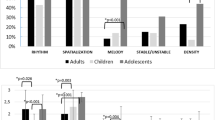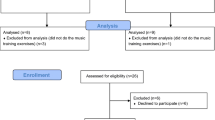Abstract
Purpose of Review
The goal of this paper is to analyze previously published literature to evaluate whether there is a relationship between music perception in cochlear implant users and duration of cochlear implant experience.
Recent Findings
There has been little research thus far on this topic. One prospective study done among Korean cochlear implant users has demonstrated passive improvement in timbre and pitch discrimination with time. It is known that speech perception does improve with time, which may point to a similar relationship in music perception as well.
Summary
Based on the available data, there is no significant passive improvement in pitch, timbre, or rhythm perception in CI users over time. There was significant heterogeneity in the methodology of music assessment and the patient populations that impacted the results of the current study. In order to improve the quality of music perception research, we advocate for standard reporting guidelines for future music perception studies.

Similar content being viewed by others
References
Papers of particular interest, published recently, have been highlighted as: • Of importance •• Of major importance
Drennan WR, Rubinstein JT. Music perception in cochlear implant users and its relationship with psychophysical capabilities. J Rehabil Res Dev. 2008;45(5):779–89. https://doi.org/10.1682/jrrd.2007.08.0118.
•• McDermott HJ. Music perception with cochlear implants: a review. Trends Amplif. 2004;8(2):49–82. https://doi.org/10.1177/108471380400800203. Review, although from some years ago, laid important groundwork for baseline music perception expectations in cochlear implant users.
Limb CJ, Rubinstein JT. Current research on music perception in cochlear implant users. Otolaryngol Clin North Am. 2012;45(1):129–40. https://doi.org/10.1016/j.otc.2011.08.021.
Shukor NFA, Lee J, Seo YJ, Han W. Efficacy of music training in hearing aid and cochlear implant users: a systematic review and meta-analysis. Clin Exp Otorhinolaryngol. 2021;14(1):15–28. https://doi.org/10.21053/ceo.2020.00101.
Krueger B, Joseph G, Rost U, Strauss-Schier A, Lenarz T, Buechner A. Performance groups in adult cochlear implant users: speech perception results from 1984 until today. Otol Neurotol. 2008;29(4):509–12. https://doi.org/10.1097/MAO.0b013e318171972f.
Ahn J, Ryu G, Cho YS. Long-term changes in musical perception in Korean cochlear implant patients. Otol Neurotol. 2019;40(3):312–20. https://doi.org/10.1097/MAO.0000000000002098.
• Gfeller K, Oleson J, Knutson JF, Breheny P, Driscoll V, Olszewski C. Multivariate predictors of music perception and appraisal by adult cochlear implant users. J Am Acad Audiol. 2008;19(2):120–134. https://doi.org/10.3766/jaaa.19.2.3. This is one of the studies that does provide some evidence that there can be improvement in domains of music perception with passive cochlear implant use over time. Studies like this are uncommon as most evaluate changes with music training rather than passive use.
Looi V, Gfeller K, Driscoll V. Music appreciation and training for cochlear implant recipients: a review. Semin Hear. 2012;33(4):307–34. https://doi.org/10.1055/s-0032-1329222.
Gfeller K, Jiang D, Oleson JJ, Driscoll V, Knutson JF. Temporal stability of music perception and appraisal scores of adult cochlear implant recipients. J Am Acad Audiol. 2010;21(1):28–34. https://doi.org/10.3766/jaaa.21.1.4.
Peterson J, Welch V, Losos M, Tugwell P. The Newcastle-Ottawa scale (NOS) for assessing the quality of nonrandomised studies in meta-analyses. Ottawa Ottawa Hospital Research Institute. 2011;2(1):1–12.
Looi V, McDermott H, McKay C, Hickson L. Music perception of cochlear implant users compared with that of hearing aid users. Ear Hear. 2008;29(3):421–34. https://doi.org/10.1097/AUD.0b013e31816a0d0b.
Brockmeier SJ, Fitzgerald D, Searle O, et al. The MuSIC perception test: a novel battery for testing music perception of cochlear implant users. Cochlear Implants Int. 2011;12(1):10–20. https://doi.org/10.1179/146701010X12677899497236.
Knapp G, Hartung J. Improved tests for a random effects meta-regression with a single covariate. Stat Med. 2003;22(17):2693–710. https://doi.org/10.1002/sim.1482.
R Core Team. R: A language and environment for statistical computing. R Foundation for Statistical Computing, Vienna, Austria. 2020.
Paule RC, Mandel J. Consensus values and weighting factors. J Res Natl Bur Stand (1977). 1982;87(5):377–85. https://doi.org/10.6028/jres.087.022.
Bakbergenuly I, Hoaglin DC, Kulinskaya E. Methods for estimating between-study variance and overall effect in meta-analysis of odds ratios. Res Synth Methods. 2020;11(3):426–42. https://doi.org/10.1002/jrsm.1404.
Caldwell MT, Jiradejvong P, Limb CJ. Impaired perception of sensory consonance and dissonance in cochlear implant users. Otol Neurotol. 2016;37(3):229–34. https://doi.org/10.1097/MAO.0000000000000960.
Gfeller K, Jiang D, Oleson JJ, et al. The effects of musical and linguistic components in recognition of real-world musical excerpts by cochlear implant recipients and normal-hearing adults. J Music Ther. 2012;49(1):68–101. https://doi.org/10.1093/jmt/49.1.68.
Cooper WB, Tobey E, Loizou PC. Music perception by cochlear implant and normal hearing listeners as measured by the Montreal Battery for Evaluation of Amusia. Ear Hear. 2008;29(4):618–26. https://doi.org/10.1097/AUD.0b013e318174e787.
Jiam NT, Deroche ML, Jiradejvong P, Limb CJ. A randomized controlled crossover study of the impact of online music training on pitch and timbre perception in cochlear implant users. J Assoc Res Otolaryngol. 2019;20(3):247–62. https://doi.org/10.1007/s10162-018-00704-0.
Smith L, Bartel L, Joglekar S, Chen J. Musical rehabilitation in adult cochlear implant recipients with a self-administered software. Otol Neurotol. 2017;38(8):e262–7. https://doi.org/10.1097/MAO.0000000000001447.
Vandali A, Sly D, Cowan R, van Hoesel R. Training of cochlear implant users to improve pitch perception in the presence of competing place cues. Ear Hear. 2015;36(2):e1–13. https://doi.org/10.1097/AUD.0000000000000109.
Neben N, Lenarz T, Schuessler M, Harpel T, Buechner A. New cochlear implant research coding strategy based on the MP3(000™) strategy to reintroduce the virtual channel effect. Acta Otolaryngol. 2013;133(5):481–90. https://doi.org/10.3109/00016489.2012.753639.
Filipo R, Ballantyne D, Mancini P, D’elia C. Music perception in cochlear implant recipients: comparison of findings between HiRes90 and HiRes120. Acta Otolaryngol. 2008;128(4):378–81. https://doi.org/10.1080/0001648070179695.
Gfeller K, Witt S, Woodworth G, Mehr MA, Knutson J. Effects of frequency, instrumental family, and cochlear implant type on timbre recognition and appraisal. Ann Otol Rhinol Laryngol. 2002;111(4):349–56. https://doi.org/10.1177/000348940211100412.
Rahne T, Böhme L, Götze G. Timbre discrimination in cochlear implant users and normal hearing subjects using cross-faded synthetic tones. J Neurosci Methods. 2011;199(2):290–5. https://doi.org/10.1016/j.jneumeth.2011.05.022.
Arnoldner C, Riss D, Brunner M, Durisin M, Baumgartner WD, Hamzavi JS. Speech and music perception with the new fine structure speech coding strategy: preliminary results. Acta Otolaryngol. 2007;127(12):1298–303. https://doi.org/10.1080/00016480701275261.
Looi V, McDermott H, McKay C, Hickson L. The effect of cochlear implantation on music perception by adults with usable pre-operative acoustic hearing. Int J Audiol. 2008;47(5):257–68. https://doi.org/10.1080/14992020801955237.
Kang R, Nimmons GL, Drennan W, et al. Development and validation of the University of Washington Clinical Assessment of Music Perception test. Ear Hear. 2009;30(4):411–8. https://doi.org/10.1097/AUD.0b013e3181a61bc0.
Gfeller K, Witt S, Adamek M, et al. Effects of training on timbre recognition and appraisal by postlingually deafened cochlear implant recipients. J Am Acad Audiol. 2002;13(3):132–45.
Müller V, Klünter H, Fürstenberg D, Meister H, Walger M, Lang-Roth R. Examination of prosody and timbre perception in adults with cochlear implants comparing different fine structure coding strategies. Am J Audiol. 2018;27(2):197–207. https://doi.org/10.1044/2017_AJA-17-0046.
Shukor NFA, Lee J, Seo YJ, Han W. Efficacy of music training in hearing aid and cochlear implant users: a systematic review and meta-analysis. Clin Exp Otorhinolaryngol. 2021;14(1):15–28. https://doi.org/10.21053/ceo.2020.00101.
Dillon MT, Buss E, Adunka MC, et al. Long-term speech perception in elderly cochlear implant users. JAMA Otolaryngol Head Neck Surg. 2013;139(3):279–83. https://doi.org/10.1001/jamaoto.2013.1814.
• Hwa TP, Wen CZ, Ruckenstein MJ. Assessment of music experience after cochlear implantation: a review of current tools and their utilization. World J Otorhinolaryngol Head Neck Surg. 2021;7(2):116–125. Published 2021 Apr 3. https://doi.org/10.1016/j.wjorl.2021.02.003. This is an important paper that goes into detail on the heterogeneity that exists within the music-perception evaluation domain. This also supports the recommendation that standardization of evaluation/data collection can help create stronger future studies.
Author information
Authors and Affiliations
Corresponding author
Ethics declarations
Conflict of Interest
The authors declare no competing interests.
Human and Animal Rights and Informed Consent
This article does not contain any studies with human or animal subjects performed by any of the authors.
Additional information
Publisher's Note
Springer Nature remains neutral with regard to jurisdictional claims in published maps and institutional affiliations.
This article is part of the Topical collection on OTOLOGY: Advances in Otology
Supplementary Information
Below is the link to the electronic supplementary material.
Rights and permissions
About this article
Cite this article
Sulibhavi, A., Wen, C.Z., Li, K. et al. The Impact of Cochlear Implant Experience on Music Perception: Systematic Review and Meta-analysis. Curr Otorhinolaryngol Rep 10, 315–321 (2022). https://doi.org/10.1007/s40136-022-00418-1
Accepted:
Published:
Issue Date:
DOI: https://doi.org/10.1007/s40136-022-00418-1




